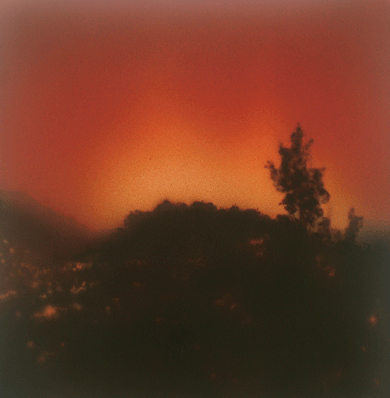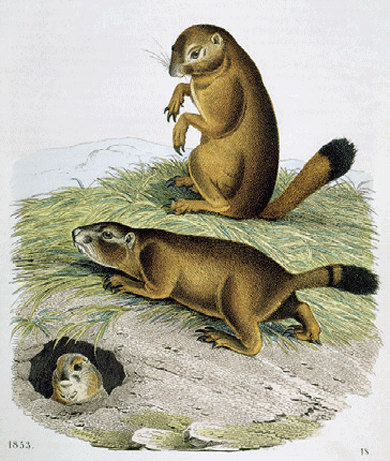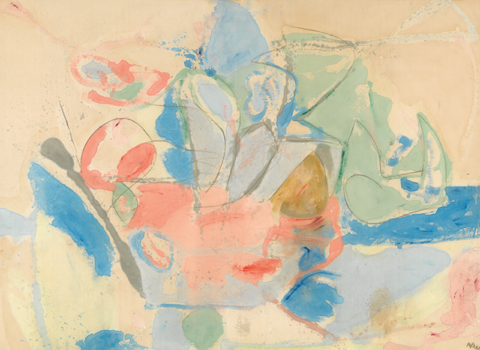It starts with a mistake; most stories do. Ex-model Luz and her ex-military boyfriend, Ray, are squatting in a dusty mansion in what used to be Laurel Canyon but is now, after a California drought of apocalyptic proportions, only “some ruined heaven.” Luz has been famous since birth as Baby Dunn, “conservation’s golden child,” the innocent whose age measures the number of years gone by without swimming pools and avocados. She’s busy trying on the clothes the mansion’s owner left behind when a prairie dog surprises her on the stairs and, unthinking, she kicks the rodent into the library. Her alarm at this wiggling sign of life brings to mind Beckett’s Hamm, who despaired at the sight of a flea: “But humanity might start from there all over again! Catch him, for the love of God!”
Ray puts the creature out of its misery, but it’s not that easy to prevent humanity from starting again. Down at the rain dance, the get-together of freaks who have refused to board the buses east, Luz and Ray spy a child toddling after a band of cretins and molesters; horrified, they steal her. Now they’re a family, and it’s time to leave town. They point their classic Karmann Ghia in the direction of the encroaching Amargosa sand dune in search of what, they have heard, is a colony. The car is green, the ground is brown. “Amargosa,” from amargo: “bitter.”

Griffith Park #2, by Samantha Fields. Courtesy the artist; Traywick Contemporary, Berkeley, California
Gold Fame Citrus (Riverhead, $27.95), Claire Vaye Watkins’s excellent new novel, follows Luz, Ray, and the baby they name Estrella from ecological waste into psychic quicksand. You will have noticed that their names are variations on a theme: identity is shifty like that in this book. Thirst has made life brittle. Yucca trees hollowed by the sun can be knocked over with a single swipe. The sand sea (“a vast tooth-colored superdune in the forgotten crook of the wasted West”) doesn’t cover things up, exactly; it crushes them, like a glacier or a rock. Watkins’s narrative voice is mythic and speculative, its sediment forming and re-forming in lists, treatises, reports. The writing, with its tough sentimentality, is reminiscent of Denis Johnson’s, but Watkins has a style of mordant observation all her own. “He was doing penance for the AWOL thing,” Luz thinks when they run out of gas and Ray, ever the deserter, says goodbye. “He was going to leave her alone to watch their child die, to prove what a good man he was.” Luz and the baby fall in with the colony, which is led by an expert dowser and spiritual creep named Levi, the author of a field guide to the Amargosa’s unusual flora and fauna. Levi bestows special favor on Luz. She has visions.
How did all of this happen? Or, to quote Mad Max: Fury Road — Who destroyed the world?
Who had latticed the Southwest with a network of aqueducts? . . . Who had diverted the coast’s rainwater and sapped the Great Basin of its groundwater? . . . If this was God he went by new names: Los Angeles City Council, Los Angeles Department of Water and Power, City of San Diego, City of Phoenix, Arizona Water and Power, New Mexico Water Commission, Las Vegas Housing and Water Authority, Bureau of Land Management, United States Department of the Interior.
Watkins knows that bureaucracy is another name for destiny, but Gold Fame Citrus is not a political thriller. Luz carries a copy of John Muir everywhere she goes, and the spirit of the Romantic sublime — of human incapacity and omnipotent terrain — is on every page. The Amargosa works like the death drive, exerting a magnetic pull on certain people, who feel themselves called to the desert — summoned, they say. It also works like God, rejecting the unfit from its dry paradise, expatriating them to civilization. “These decisions had been made before this discussion,” Luz thinks near the end of the novel, “before the prairie dog crossed their threshold.” We find out who Levi really is, but not all forces of nature are demystified: not the sea, where Luz’s mother drowned years ago; not erotic attraction, which Luz compares to telepathy (“the wild luck of two people feeling the exact same thing at the exact same time”); not the stirrings of maternal feeling for little Estrella.
Is Luz a good mother? She tries. But we inherit the world our progenitors made, just as we inherit their ways of making it. “You spend your life thinking you’re an original,” Luz says. “Then one day you realize you’ve been acting just like your parents.” That this statement can plausibly endure when water has turned to salt is both terrifying and strangely soothing. I suppose it all depends on who your parents are. Watkins’s father is a former member of the Manson Family.
Readers of Jay Nordlinger’s Children of Monsters (Encounter Books, $25.99), a sketchy treatment of the children of twenty twentieth-century dictators, might find themselves concluding that unhappy families are more alike than is commonly asserted. But perhaps that only represents the view from outside the garden gates. Even in the age of the Internet there are mysteries that research cannot penetrate. Franco and Pol Pot had one daughter each; Hitler may have had a son. But how many children did Idi Amin have? Sixty? As for what it all means, Nordlinger, whose favorite analytic category is “evil,” can’t say.

Joseph Stalin with his children Vasily and Svetlana, 1930s. Photograph by Pyotr Otsup © Heritage Image Partnership Ltd./Alamy
Being a dictator’s child seems a bit like being the child of any rich workaholic — nanny, boarding school, travel and/or exile. Many have earned advanced degrees, becoming engineers, scientists, or professors; a few have actually written their own dissertations. Valentin Ceau sescu and Uday Hussein both oversaw soccer organizations; Saadi Qaddafi captained the national squad. (Antonio Castro, a surgeon, was the Cuban baseball team’s doctor.) Maher al-Assad took charge of the military. A handful of sons (alleged rapists and torturers Uday Hussein, Vasily Stalin, and Nicu Ceausescu) are outright villains. Jean-Claude “Baby Doc” Duvalier, Bashar al-Assad, Kim Jong-il, and Kim Jong-un inherited the family business, though the smart and politically savvy daughters — Marie-Denise Duvalier, Bushra al-Assad, and Kim Sul-song — were denied succession. Reunions can be tense affairs, particularly when daughters have chosen objectionable husbands; Mussolini and Saddam both had sons-in-law killed. Mao, who had ten children, didn’t see them more than a few times a year. He may have sent one of his daughters to a reeducation camp.
Nordlinger has sympathy for the dissenters: Jaffar Amin, who describes himself as a “social democrat on the Norwegian model” and has pushed for a truth and reconciliation commission in Uganda; Hussein Khomeini, who would not be oppposed to an American invasion of Iran; and the daughters of Stalin and Fidel Castro, both of whom defected to the United States. Incidentally, Stalin’s daughter, Svetlana, was an avid reader of National Review, where Nordlinger is a senior editor. (Even so, she does not receive a free pass. Her remarks on the similarities between the United States and the U.S.S.R. are in line with “any number of professors on American campuses.”)
Not that everything is Father’s fault. Neither Jiang Qing, Mao’s fourth wife, nor Svetlana’s mother, Nadezhda Alliluyeva, was “maternal.” (Nordlinger: “We might pause to imagine a household in which Stalin is the more loving parent.”) But how should a woman be? Carmen Franco and Raghad Hussein are tsked for having plastic surgery, while the twin sisters Mobutu took as wife and mistress “grew plump with time.” Saddam’s second wife, Samira, was a “femme fatale.” Albania’s Ermal Hoxha married a “hot tamale.”
Hannah Arendt said that natality, “the new beginning inherent in birth,” is “the miracle that saves the world.” But people are born into families, and all parents are, for a few years, anyway, totalitarians who wield the ultimate dictatorial power: the power to shape reality. Every child thinks her family is normal until she starts receiving news of how they live next door. Laws, rights, and status are not universal. Procedures vary. Regime change can be traumatic, whether the path is one of revolution or reform. Nordlinger characterizes his project as, “in part, a psychological study, I suppose,” though it reads more like a collection of Wikipedia entries. The real question to ask about families is this: are they doomed to reproduce their own small fascisms, training the younger subjects to desire absolute power over others? Or can they — somehow — rear individuals capable of truly democratic relations?
It is truly democratic relations that will be required, Jedediah Purdy writes in After Nature: A Politics for the Anthropocene (Harvard University Press, $29.95), to address our age of “permanent crises”: loss of species and habitats, resource depletion, drought. The Anthropocene, the name lately given to this era in which nature cannot be said to exist untouched by human intervention — an era variously dated to the nuclear bomb, the Industrial Revolution, and the dawn of agriculture — has been a topic for scientific inquiry, moral piety, and existential despair; in June, Pope Francis made it a matter of spiritual urgency. But for Purdy, a law professor at Duke, paradigmatic Anthropocene issues like climate change, food, and animal welfare are political problems. This does not mean that political solutions are readily forthcoming.
Real environmental reform is a matter of political economy. That is, it requires engaging the foundations of economic life: what kind of wealth an economy produces, how it distributes that wealth, what kind of freedom and equality it promotes, and what provision it makes for the future. These are political questions whose answers must be worked out through economic institutions. But the politics of modern democracies has become less able to engage such questions, even as the questions have become harder and more urgent.
There is, nonetheless, no alternative to politics. “The democratic responsibility,” Purdy writes, “is the responsibility of making a world.” Anthropocene thinking teaches that the environment is not something to save but something that we will change and change again. An Anthropocene politics is one that acts on behalf of unborn generations. It asks the living to be the miracle that saves the world.
After Nature explains four kinds of “environmental imagination” that have shaped the concept of nature in American law and experience; their thrust has been quarry and quarantine. The settlers who “cleared” the West were moved by a providential vision; John Muir and the Sierra Club represent the Romantic imagination; Progressive Era conservationists brought utilitarian thinking to the administration and management of parks; and writers like Rachel Carson developed an ecological imagination, in which nature was understood as a system of interdependent parts. Every image of nature has its corresponding economic and political system. The settlers, for example, called for the land to be tilled and developed, which required the expulsion of Native Americans, while the technocratic values of the Progressive reformers were perfect for a consumer society of vacationers who wanted to be back in the office on Monday morning.
Muir’s notion of “wilderness” is key. (In his pursuit of it, Muir turned Thoreau — for whom, Purdy writes, “profanation is simply the condition of the world” — into an intellectual ally, someone looking for a temporary escape from society, when the point of Walden was in fact to transform society.) Wilderness thinking imagined nature as something set aside for restorative solitude, and environmentalism thus set itself apart from work, apart from ugliness — apart from people. The Sierra Club made possible the maintenance and preservation of thousands of acres of pristine land. But when the high mountain landscape becomes sacred, Purdy writes, ordinary places “are treated as industrial reserves.” The contemporary food movement, to its credit, moves away from this kind of thinking. It marries an ecological mind-set, which grasps nature as a holistic system, to the settler mentality that dignified work.
“Look at that lizard,” my husband said to me recently, as we enjoyed a scenic vista courtesy of Teddy Roosevelt and the National Park System. “Once his kind ruled the earth.” The fantasy of our coming extinction so often exudes a pleasant, lotus-eating inevitability. False prophets, or mass-murdering dictators, or garden-variety pain and suffering are invoked to win the case against humanity. Maybe it will be better when we’re gone, a voice of comfortable melancholy says; maybe that’s what we deserve. There’s that flea, beating his fragile wings. Catch him — quick! — before it all starts up again. After Nature argues that we will deserve the future only because it will be the one we made. We will live, or die, by our mistakes.









































































































